
Am Fam Physician. 2023;108(3):278-287
Author disclosure: No relevant financial relationships.
Delirium is an acute disturbance in attention, cognition, and awareness that fluctuates over time. Delirium is characterized by three subtypes: hyperactive, hypoactive, and mixed. It occurs in 11% to 25% of older adults in inpatient settings and is associated with a significant financial burden. Older age, multiple comorbidities, recent surgery, and polypharmacy are independent risk factors for delirium. The diagnosis is clinical but can be challenging due to overlapping symptoms with dementia and depression. The Confusion Assessment Method is a screening tool that is 94% to 100% sensitive and 90% to 95% specific for delirium. There is no evidence to support medication use for delirium prevention. Nonpharmacologic interventions, such as sufficient hydration and nutrition, early mobilization, infection control, and frequent orientation, can prevent and treat delirium. Physical restraints should be avoided, but if needed in patients at significant risk of injury to themselves or others, their use should be reassessed at least every 24 hours. No medications are approved by the U.S. Food and Drug Administration for the treatment of delirium. If pharmacologic therapy is indicated, second-generation antipsychotics such as olanzapine, risperidone, and quetiapine are preferred over haloperidol because of their faster onset of action and fewer adverse effects. Patients hospitalized with prolonged delirium have approximately three times the chance of dying in the following year compared with patients with a quick resolution of delirium or no symptoms; therefore, prevention and early detection should be emphasized.
Delirium is a syndrome characterized by an acute disturbance in attention, cognition, and awareness that develops within hours to days and fluctuates in severity over time. There are three subtypes of psychomotor disturbances of delirium: hyperactive, hypoactive, and mixed.1 Hyperactive delirium is marked by agitation and restlessness and can be misdiagnosed as primary psychosis or dementia. Hypoactive delirium is characterized by lethargy and psychomotor impairment and can be mistaken for depression. Mixed delirium has hyperactive and hypoactive features.1 Historically, the terms delirium, acute encephalopathy, acute confusional state, acute brain dysfunction, acute brain failure, and altered mental status have been used interchangeably and imprecisely. Delirium and acute encephalopathy are the most accepted terms and refer to a deviation from the patient's baseline cognition.2 An accurate diagnosis of delirium is essential to prevent inappropriate treatments, prolonged hospitalization, cognitive decline, and increased mortality and morbidity.3,4
| Clinical recommendation | Evidence rating | Comments |
|---|---|---|
| The Confusion Assessment Method is the most accurate tool for diagnosing delirium in adults.24 | C | Systematic review |
| The Hospital Elder Life Program is a multidisciplinary strategy that addresses sleep hygiene, cognitive impairment, immobility, visual and hearing impairment, and dehydration and should be used to prevent delirium.28 | B | Systematic review |
| Medications should not be used for the prevention of delirium in hospitalized patients.4 | A | Systematic review |
| The combination of lorazepam with haloperidol is more effective than haloperidol alone for reducing agitated delirium in patients with advanced cancer.46 | B | Double-blind, randomized controlled trial |
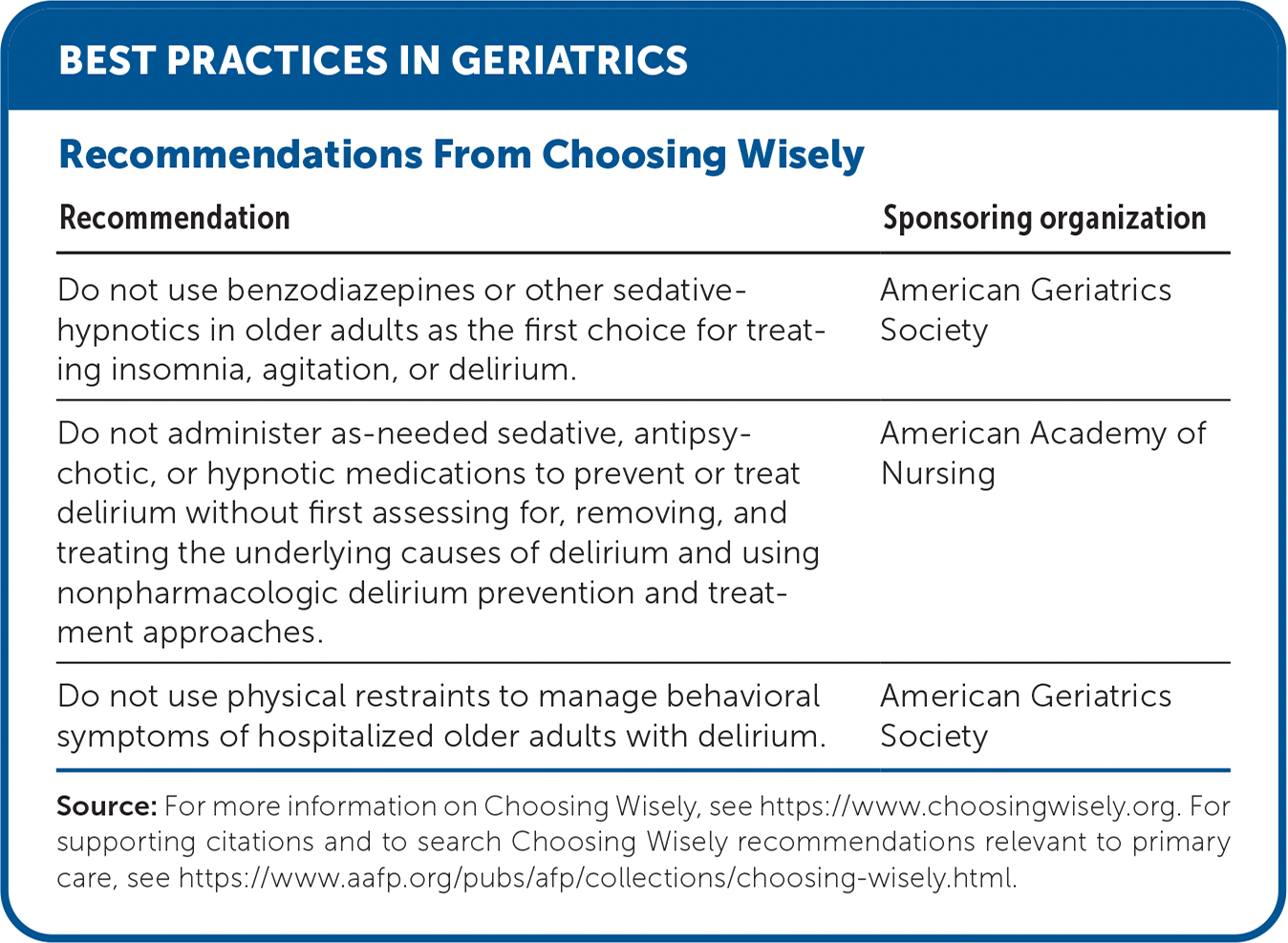
| Recommendation | Sponsoring organization |
|---|---|
| Do not use benzodiazepines or other sedative-hypnotics in older adults as the first choice for treating insomnia, agitation, or delirium. | American Geriatrics Society |
| Do not administer as-needed sedative, antipsychotic, or hypnotic medications to prevent or treat delirium without first assessing for, removing, and treating the underlying causes of delirium and using nonpharmacologic delirium prevention and treatment approaches. | American Academy of Nursing |
| Do not use physical restraints to manage behavioral symptoms of hospitalized older adults with delirium. | American Geriatrics Society |
Epidemiology
Delirium is among the most common complications in hospitalized adults 65 years and older.5 It is the most common surgical complication in older adults and is associated with a significant financial burden.6 National health care costs related to postoperative delirium are an estimated $32.9 billion per year, with most costs from the lengthening of the initial hospitalization, subsequent hospitalizations, and acute rehabilitation.7 Overall costs attributable to delirium are significantly higher, ranging from $143 billion to $152 billion per year, which includes factors such as prolonged hospitalizations, outpatient visits, and nursing home stays.3
The prevalence of delirium in the community is relatively low at 1% to 2% but increases to approximately 11% to 25% with hospital admission. This dramatic difference in prevalence may be due to the symptoms of delirium prompting evaluation of the patient in a more acute setting such as the emergency department.5,8 The incidence of delirium differs significantly depending on the health care setting and the patient's associated risk factors (Table 1).3,5,9,10 The prevalence and incidence of delirium are likely underestimated because patients with baseline cognitive impairment or dementia are often excluded from studies.5
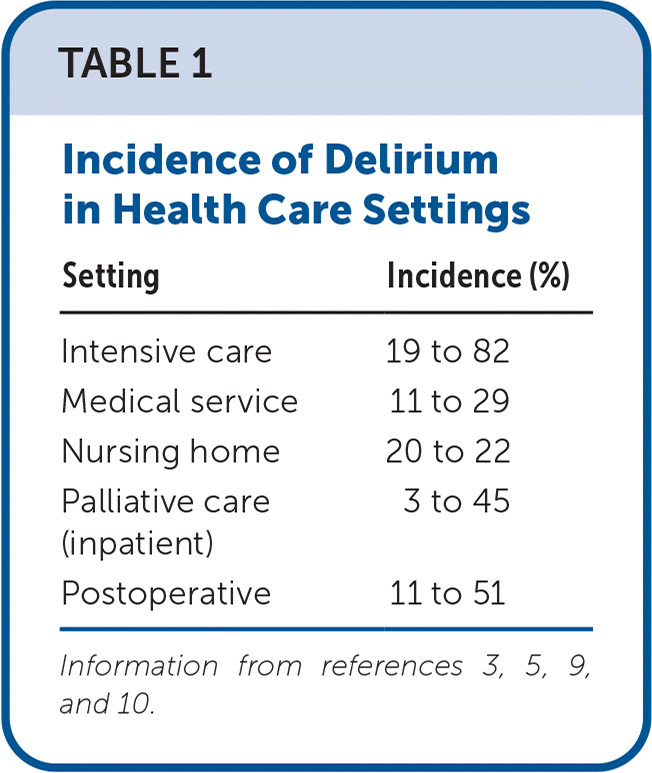
| Setting | Incidence (%) |
|---|---|
| Intensive care | 19 to 82 |
| Medical service | 11 to 29 |
| Nursing home | 20 to 22 |
| Palliative care (inpatient) | 3 to 45 |
| Postoperative | 11 to 51 |
Pathophysiology and Risk Factors
The pathophysiologic cause of delirium is not well understood.1 Older age, multiple comorbidities, polypharmacy, poor baseline functional status, and recent surgery are all independent risk factors for developing delirium (Table 2).8,11–15 Predisposing factors are the patient's background characteristics, whereas precipitating factors are acute or subacute events preceding onset of delirium.16 Patients with delirium are typically affected by more than one risk factor and often have predisposing and precipitating elements.17 It is unlikely that only one mechanism is responsible for the cause of delirium because of the variation in risk factors.13,16 The range of potential etiologies poses a complex challenge in identifying precipitating factors but is important because delirium is reversible in 25% to 68% of patients.18
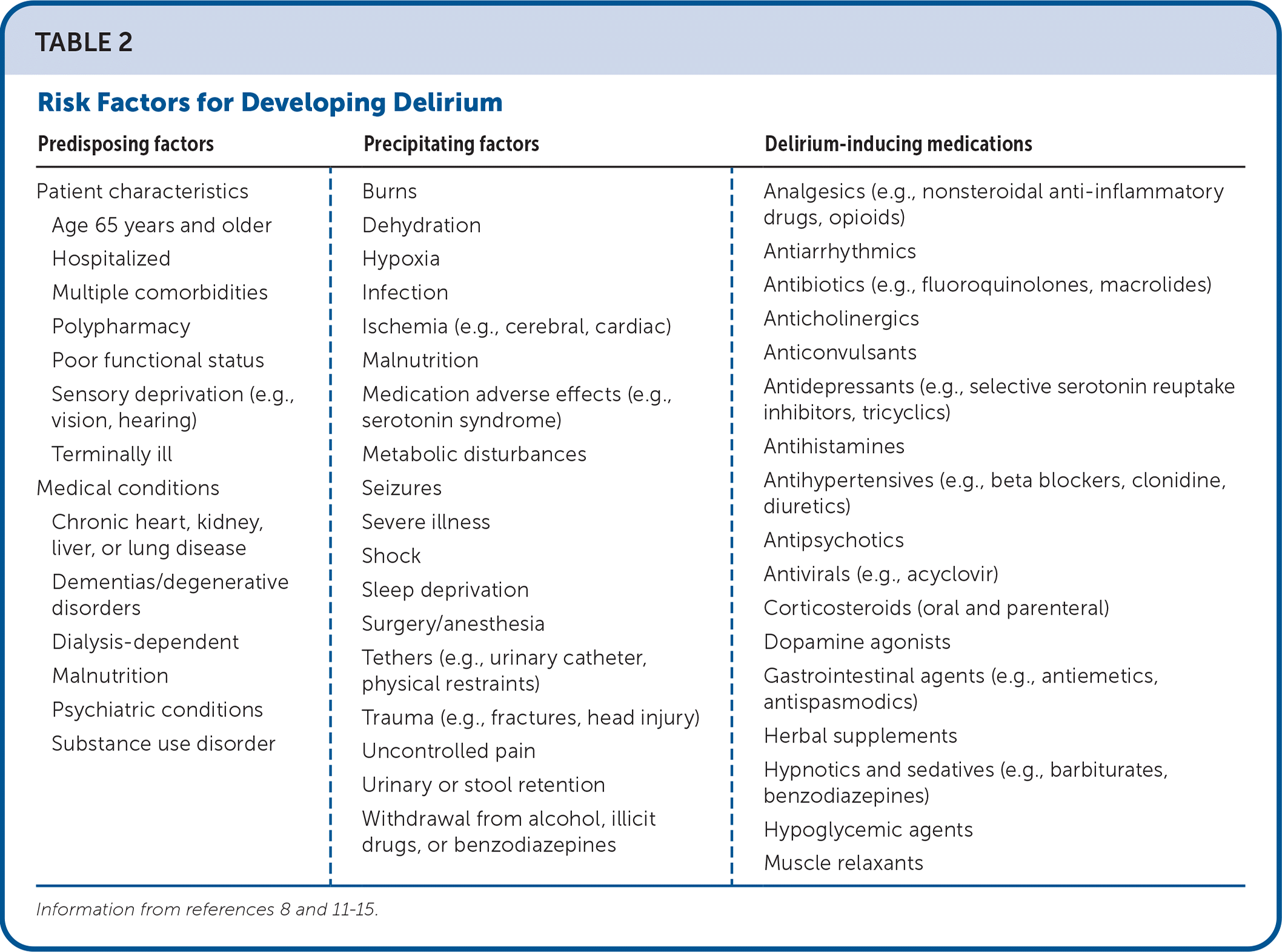
| Predisposing factors | Precipitating factors | Delirium-inducing medications |
|---|---|---|
| Patient characteristics Age 65 years and older Hospitalized Multiple comorbidities Polypharmacy Poor functional status Sensory deprivation (e.g., vision, hearing) Terminally ill Medical conditions Chronic heart, kidney, liver, or lung disease Dementias/degenerative disorders Dialysis-dependent Malnutrition Psychiatric conditions Substance use disorder | Burns Dehydration Hypoxia Infection Ischemia (e.g., cerebral, cardiac) Malnutrition Medication adverse effects (e.g., serotonin syndrome) Metabolic disturbances Seizures Severe illness Shock Sleep deprivation Surgery/anesthesia Tethers (e.g., urinary catheter, physical restraints) Trauma (e.g., fractures, head injury) Uncontrolled pain Urinary or stool retention Withdrawal from alcohol, illicit drugs, or benzodiazepines | Analgesics (e.g., nonsteroidal anti-inflammatory drugs, opioids) Antiarrhythmics Antibiotics (e.g., fluoroquinolones, macrolides) Anticholinergics Anticonvulsants Antidepressants (e.g., selective serotonin reuptake inhibitors, tricyclics) Antihistamines Antihypertensives (e.g., beta blockers, clonidine, diuretics) Antipsychotics Antivirals (e.g., acyclovir) Corticosteroids (oral and parenteral) Dopamine agonists Gastrointestinal agents (e.g., antiemetics, antispasmodics) Herbal supplements Hypnotics and sedatives (e.g., barbiturates, benzodiazepines) Hypoglycemic agents Muscle relaxants |
Diagnosis
Patients with suspected delirium should have a comprehensive history and physical examination for possible contributing medical conditions. Delirium can be precipitated by medications, adverse medication effects, uncontrolled pain, infections, severe organ damage, drug or alcohol withdrawal, dehydration, and constipation (Table 319,20). Timely identification of the etiology of symptoms is important.14,21
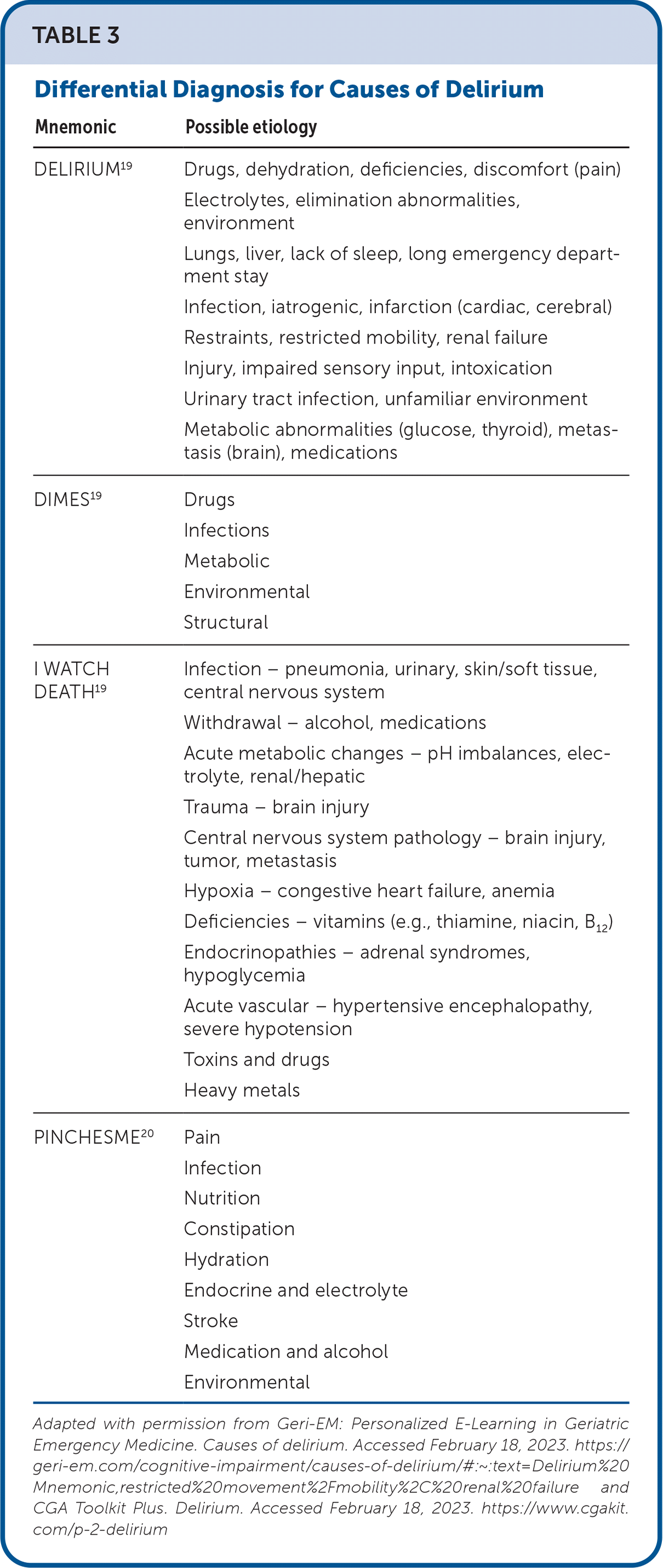
| Mnemonic | Possible etiology |
|---|---|
| DELIRIUM19 | Drugs, dehydration, deficiencies, discomfort (pain) |
| Electrolytes, elimination abnormalities, environment | |
| Lungs, liver, lack of sleep, long emergency department stay | |
| Infection, iatrogenic, infarction (cardiac, cerebral) | |
| Restraints, restricted mobility, renal failure | |
| Injury, impaired sensory input, intoxication | |
| Urinary tract infection, unfamiliar environment | |
| Metabolic abnormalities (glucose, thyroid), metastasis (brain), medications | |
| DIMES19 | Drugs |
| Infections | |
| Metabolic | |
| Environmental | |
| Structural | |
| I WATCH DEATH19 | Infection – pneumonia, urinary, skin/soft tissue, central nervous system |
| Withdrawal – alcohol, medications | |
| Acute metabolic changes – pH imbalances, electrolyte, renal/hepatic | |
| Trauma – brain injury | |
| Central nervous system pathology – brain injury, tumor, metastasis | |
| Hypoxia – congestive heart failure, anemia | |
| Deficiencies – vitamins (e.g., thiamine, niacin, B12) | |
| Endocrinopathies – adrenal syndromes, hypoglycemia | |
| Acute vascular – hypertensive encephalopathy, severe hypotension | |
| Toxins and drugs | |
| Heavy metals | |
| PINCHESME20 | Pain |
| Infection | |
| Nutrition | |
| Constipation | |
| Hydration | |
| Endocrine and electrolyte | |
| Stroke | |
| Medication and alcohol | |
| Environmental |
The diagnosis of delirium can be clinically challenging due to its overlapping symptoms with other diagnoses, such as depression and dementia, fluctuation of symptoms, and hypoactivity.22 It may be helpful to document the patient's baseline level of alertness and ability to participate in interactions appropriately. Informants, such as family members and friends, should be questioned if this information is not readily available.
The National Institute for Health and Care Excellence guidelines advocate for daily observation for changes in behavior, specifically in patients identified as being at high risk during the assessment of medical disposition, baseline physical and cognitive impairments, and social behaviors.23 A trained clinician should perform a clinical assessment if any behavior changes are present.
Initially developed in the late 1980s, the Confusion Assessment Method was created to increase recognition of delirium.24 This tool provides a standardized method enabling nonpsychiatric-trained clinicians to identify delirium quickly and accurately in clinical settings. A positive screen for delirium requires an abnormal rating for criteria 1 and 2 and either 3 or 4 (Table 4).14 Guidelines and societies, including the American Psychiatric Association, American College of Emergency Physicians, and the Society for Critical Care Medicine, recommend the Confusion Assessment Method.24 A positive result carries a 94% to 100% sensitivity and 90% to 95% specificity.
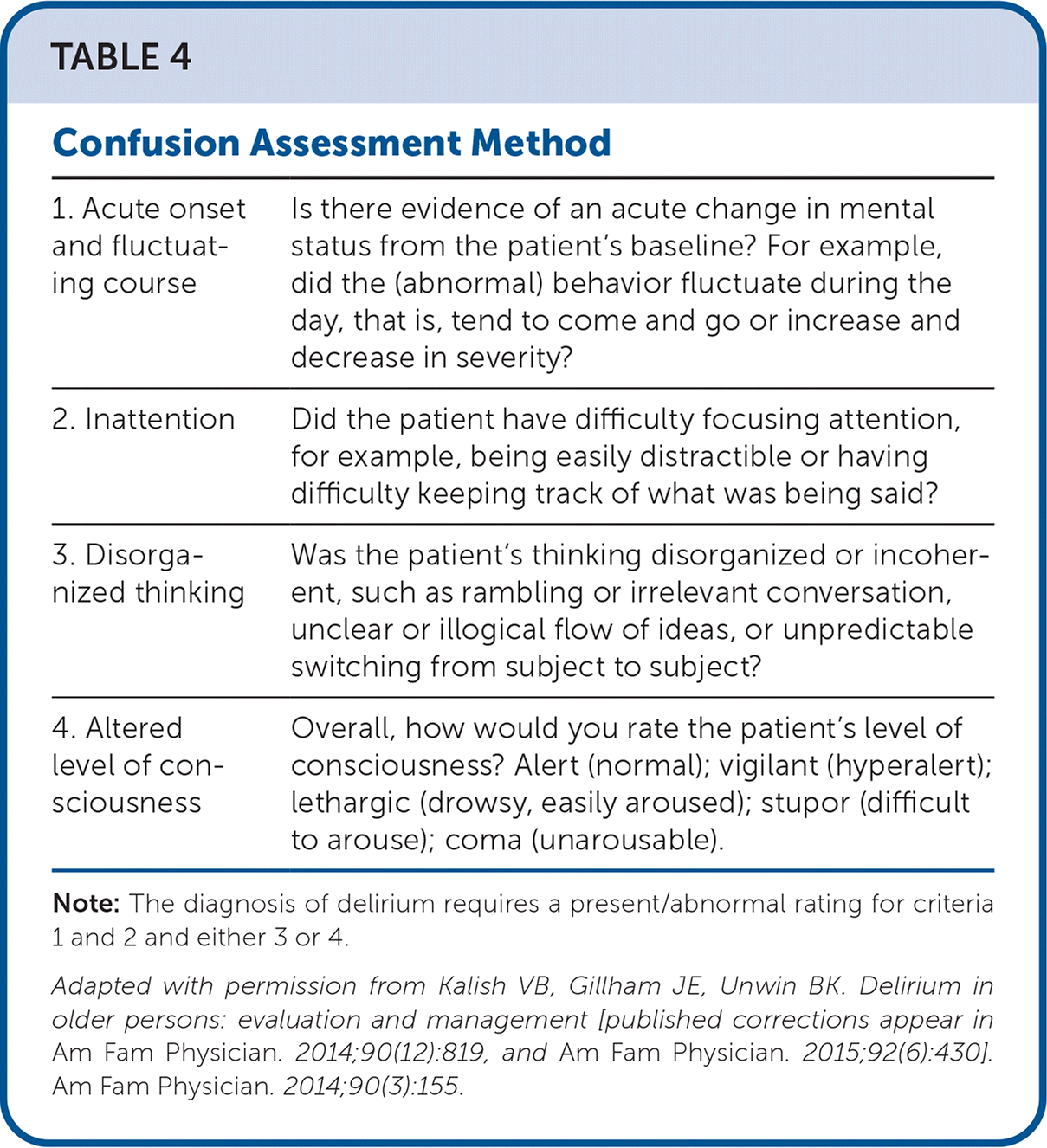
| 1. Acute onset and fluctuating course | Is there evidence of an acute change in mental status from the patient's baseline? For example, did the (abnormal) behavior fluctuate during the day, that is, tend to come and go or increase and decrease in severity? |
| 2. Inattention | Did the patient have difficulty focusing attention, for example, being easily distractible or having difficulty keeping track of what was being said? |
| 3. Disorganized thinking | Was the patient's thinking disorganized or incoherent, such as rambling or irrelevant conversation, unclear or illogical flow of ideas, or unpredictable switching from subject to subject? |
| 4. Altered level of consciousness | Overall, how would you rate the patient's level of consciousness? Alert (normal); vigilant (hyperalert); lethargic (drowsy, easily aroused); stupor (difficult to arouse); coma (unarousable). |
If a formal diagnosis of delirium is required, the Diagnostic and Statistical Manual of Mental Disorders, 5th ed., text revision (DSM-5-TR) updated the four criteria required for diagnosis in 2022.25 This version clarifies some of the terminology from the 2014 publication25 (Table 526). The DSM-5 classification of delirium includes (1) a disturbance in attention, (2) an acute change from baseline, (3) a disturbance in cognition, (4) that the first two criteria are not better explained by another preexisting neurocognitive diagnosis, and (5) that the disturbance is not a direct consequence of another medical condition.27
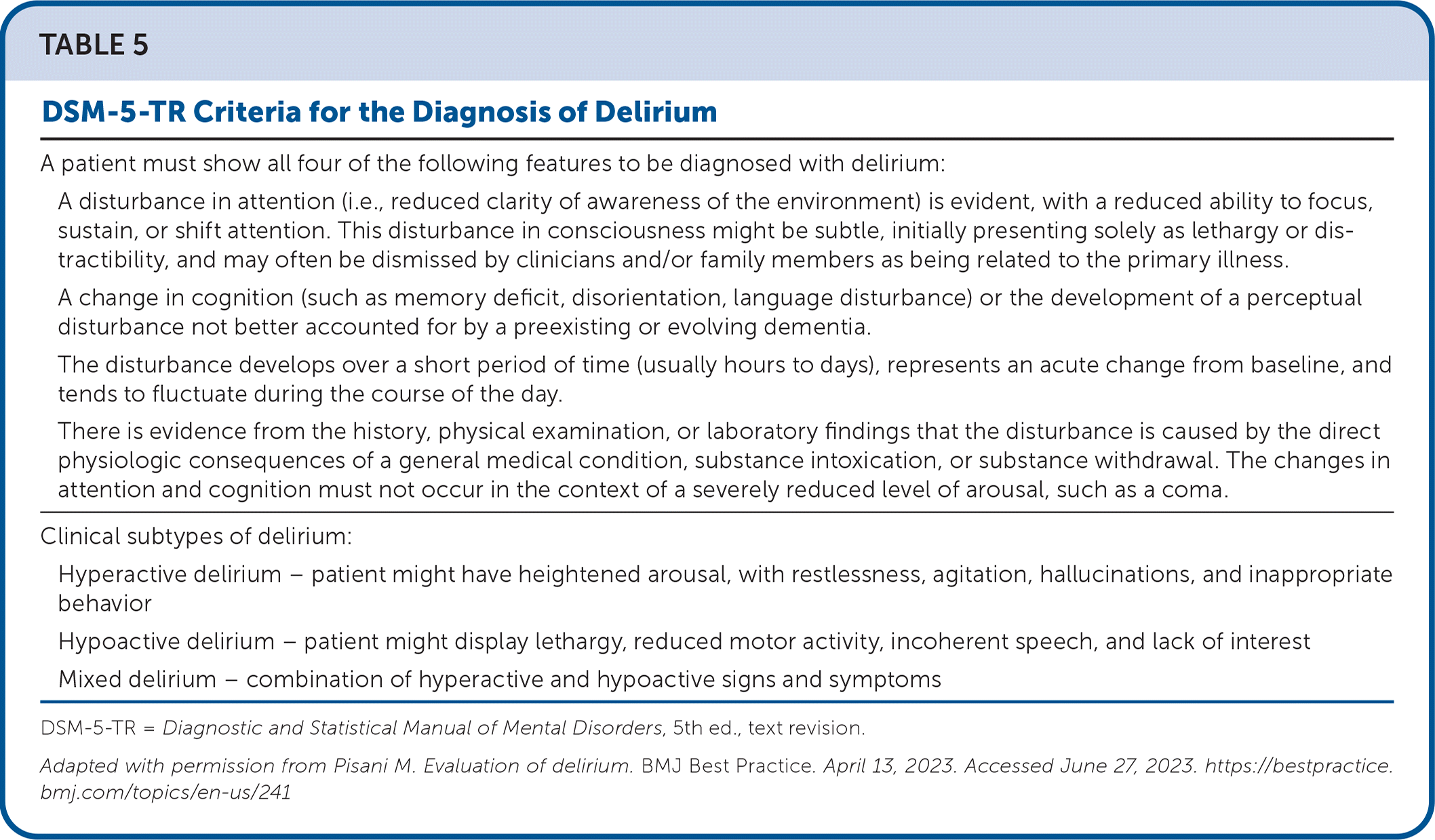
| A patient must show all four of the following features to be diagnosed with delirium: |
| A disturbance in attention (i.e., reduced clarity of awareness of the environment) is evident, with a reduced ability to focus, sustain, or shift attention. This disturbance in consciousness might be subtle, initially presenting solely as lethargy or distractibility, and may often be dismissed by clinicians and/or family members as being related to the primary illness. |
| A change in cognition (such as memory deficit, disorientation, language disturbance) or the development of a perceptual disturbance not better accounted for by a preexisting or evolving dementia. |
| The disturbance develops over a short period of time (usually hours to days), represents an acute change from baseline, and tends to fluctuate during the course of the day. |
| There is evidence from the history, physical examination, or laboratory findings that the disturbance is caused by the direct physiologic consequences of a general medical condition, substance intoxication, or substance withdrawal. The changes in attention and cognition must not occur in the context of a severely reduced level of arousal, such as a coma. |
| Clinical subtypes of delirium: |
| Hyperactive delirium – patient might have heightened arousal, with restlessness, agitation, hallucinations, and inappropriate behavior |
| Hypoactive delirium – patient might display lethargy, reduced motor activity, incoherent speech, and lack of interest |
| Mixed delirium – combination of hyperactive and hypoactive signs and symptoms |
Treatment of Delirium
PREVENTION
The optimal treatment for delirium is prevention. Most preventive protocols use a multidisciplinary, nonpharmacologic strategy to mitigate the pre-disposing and precipitating factors for delirium. One such intervention is the Hospital Elder Life Program. This multicomponent strategy tries to prevent cognitive and functional decline in hospitalized older adults by targeting risk factors for delirium, such as lack of sleep, cognitive impairment, immobility, visual and hearing impairment, and dehydration.28 A meta-analysis of 14 studies worldwide demonstrated a significant reduction in delirium, falls, hospital length of stay, and acute and long-term care costs when using the Hospital Elder Life Program. The meta-analysis also showed improvement in patient satisfaction and overall health care quality.28 There is currently no evidence to support medication use for delirium prevention.4 Several other interventions may prevent delirium before and during hospitalization (Table 6).5,12,21,29
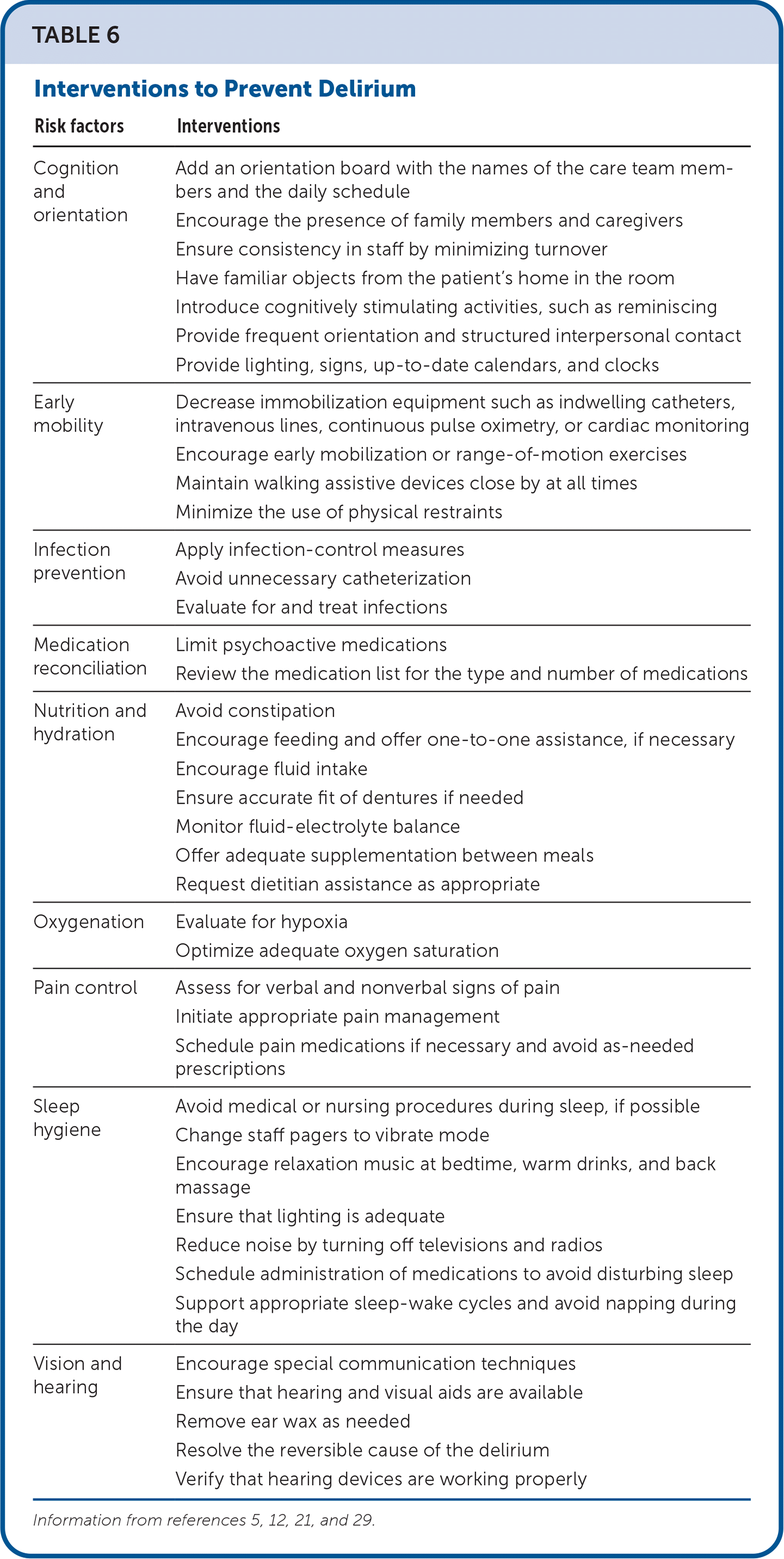
| Risk factors | Interventions |
|---|---|
| Cognition and orientation | Add an orientation board with the names of the care team members and the daily schedule |
| Encourage the presence of family members and caregivers | |
| Ensure consistency in staff by minimizing turnover | |
| Have familiar objects from the patient's home in the room | |
| Introduce cognitively stimulating activities, such as reminiscing | |
| Provide frequent orientation and structured interpersonal contact | |
| Provide lighting, signs, up-to-date calendars, and clocks | |
| Early mobility | Decrease immobilization equipment such as indwelling catheters, intravenous lines, continuous pulse oximetry, or cardiac monitoring |
| Encourage early mobilization or range-of-motion exercises | |
| Maintain walking assistive devices close by at all times | |
| Minimize the use of physical restraints | |
| Infection prevention | Apply infection-control measures |
| Avoid unnecessary catheterization | |
| Evaluate for and treat infections | |
| Medication reconciliation | Limit psychoactive medications |
| Review the medication list for the type and number of medications | |
| Nutrition and hydration | Avoid constipation |
| Encourage feeding and offer one-to-one assistance, if necessary | |
| Encourage fluid intake | |
| Ensure accurate fit of dentures if needed | |
| Monitor fluid-electrolyte balance | |
| Offer adequate supplementation between meals | |
| Request dietitian assistance as appropriate | |
| Oxygenation | Evaluate for hypoxia |
| Optimize adequate oxygen saturation | |
| Pain control | Assess for verbal and nonverbal signs of pain |
| Initiate appropriate pain management | |
| Schedule pain medications if necessary and avoid as-needed prescriptions | |
| Sleep hygiene | Avoid medical or nursing procedures during sleep, if possible |
| Change staff pagers to vibrate mode | |
| Encourage relaxation music at bedtime, warm drinks, and back massage | |
| Ensure that lighting is adequate | |
| Reduce noise by turning off televisions and radios | |
| Schedule administration of medications to avoid disturbing sleep | |
| Support appropriate sleep-wake cycles and avoid napping during the day | |
| Vision and hearing | Encourage special communication techniques |
| Ensure that hearing and visual aids are available | |
| Remove ear wax as needed | |
| Resolve the reversible cause of the delirium | |
| Verify that hearing devices are working properly |
If a patient in the community is suspected of having delirium, continued outpatient care is appropriate when the evaluation for delirium can be expedited.26 It is accepted that delirium is worse in older patients when they are away from a familiar environment.30 Hospitalization may be required if there is inadequate support or concern for patient safety. Delirium may be secondary to acute and severe disease and may require expedited care, a multidisciplinary strategy, and close monitoring in the inpatient setting.12,30 The benefits and burdens of each setting should be considered when treating patients with delirium.
NONPHARMACOLOGIC THERAPY
Nonpharmacologic interventions are the foundation of delirium management and prevention. A meta-analysis of four randomized trials found a 44% decrease in delirium with conservative treatment only.31 Nonpharmacologic management includes sufficient hydration and nutrition, early mobilization, pain management, infection prevention, and frequent orientation.14,31 Similar interventions can be used in other settings, including outpatient, inpatient, subacute care, long-term care, and hospice.21,31 The use of opioids and untreated pain may exacerbate delirium; therefore, using the lowest and most effective dosage and switching between different opioid classes may be necessary to achieve pain control.32 Physical restraints should be avoided because they have been correlated with worse outcomes. Restraints may be needed in patients who demonstrate a significant risk of injury to themselves or others after all other treatment options have been exhausted. The necessity for physical restraints should be reassessed at least every 24 hours unless otherwise mandated.5,12
PHARMACOLOGIC THERAPY
Medications to treat delirium should be used only when conservative treatment has been ineffective and the patient displays severe agitation associated with an increased risk of substantial harm to self or others.21,29 There are no medications approved for the treatment of delirium by the U.S. Food and Drug Administration (FDA) due to limited supporting evidence. Antipsychotic drugs may reduce agitation in older patients with acute delirium. If pharmacologic therapy for delirium is indicated, the lowest effective dose, for the shortest duration needed, is recommended (Table 7).14,21,29,33–35 Second-generation antipsychotics such as olanzapine (Zyprexa), risperidone (Risperdal), and quetiapine are preferred over haloperidol because of their faster onset of action and fewer adverse effects.36
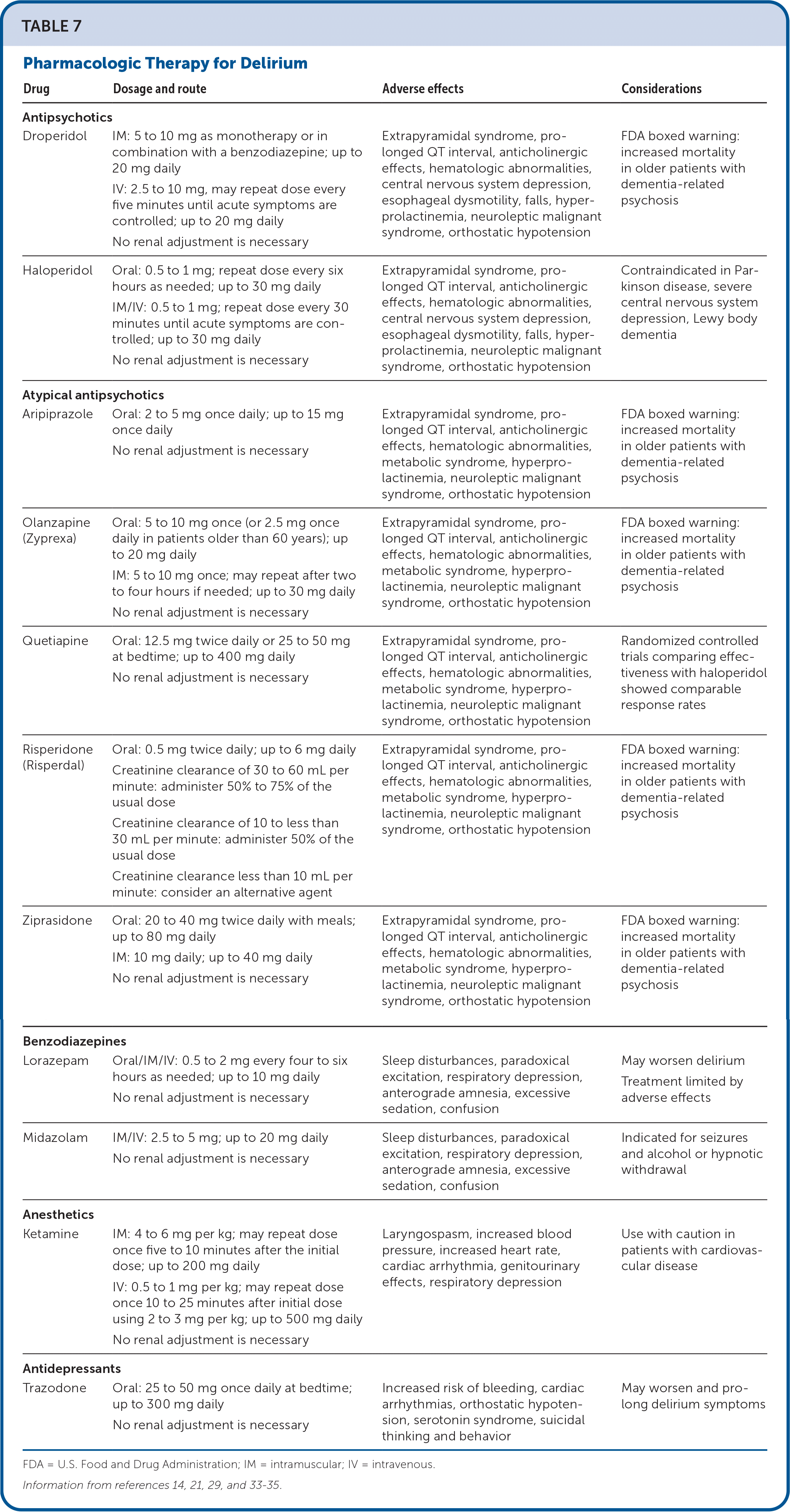
| Drug | Dosage and route | Adverse effects | Considerations |
|---|---|---|---|
| Antipsychotics | |||
| Droperidol | IM: 5 to 10 mg as monotherapy or in combination with a benzodiazepine; up to 20 mg daily IV: 2.5 to 10 mg, may repeat dose every five minutes until acute symptoms are controlled; up to 20 mg daily No renal adjustment is necessary | Extrapyramidal syndrome, prolonged QT interval, anticholinergic effects, hematologic abnormalities, central nervous system depression, esophageal dysmotility, falls, hyperprolactinemia, neuroleptic malignant syndrome, orthostatic hypotension | FDA boxed warning: increased mortality in older patients with dementia-related psychosis |
| Haloperidol | Oral: 0.5 to 1 mg; repeat dose every six hours as needed; up to 30 mg daily IM/IV: 0.5 to 1 mg; repeat dose every 30 minutes until acute symptoms are controlled; up to 30 mg daily No renal adjustment is necessary | Extrapyramidal syndrome, prolonged QT interval, anticholinergic effects, hematologic abnormalities, central nervous system depression, esophageal dysmotility, falls, hyperprolactinemia, neuroleptic malignant syndrome, orthostatic hypotension | Contraindicated in Parkinson disease, severe central nervous system depression, Lewy body dementia |
| Atypical antipsychotics | |||
| Aripiprazole | Oral: 2 to 5 mg once daily; up to 15 mg once daily No renal adjustment is necessary | Extrapyramidal syndrome, prolonged QT interval, anticholinergic effects, hematologic abnormalities, metabolic syndrome, hyperprolactinemia, neuroleptic malignant syndrome, orthostatic hypotension | FDA boxed warning: increased mortality in older patients with dementia-related psychosis |
| Olanzapine (Zyprexa) | Oral: 5 to 10 mg once (or 2.5 mg once daily in patients older than 60 years); up to 20 mg daily IM: 5 to 10 mg once; may repeat after two to four hours if needed; up to 30 mg daily No renal adjustment is necessary | Extrapyramidal syndrome, prolonged QT interval, anticholinergic effects, hematologic abnormalities, metabolic syndrome, hyperprolactinemia, neuroleptic malignant syndrome, orthostatic hypotension | FDA boxed warning: increased mortality in older patients with dementia-related psychosis |
| Quetiapine | Oral: 12.5 mg twice daily or 25 to 50 mg at bedtime; up to 400 mg daily No renal adjustment is necessary | Extrapyramidal syndrome, prolonged QT interval, anticholinergic effects, hematologic abnormalities, metabolic syndrome, hyperprolactinemia, neuroleptic malignant syndrome, orthostatic hypotension | Randomized controlled trials comparing effectiveness with haloperidol showed comparable response rates |
| Risperidone (Risperdal) | Oral: 0.5 mg twice daily; up to 6 mg daily Creatinine clearance of 30 to 60 mL per minute: administer 50% to 75% of the usual dose Creatinine clearance of 10 to less than 30 mL per minute: administer 50% of the usual dose Creatinine clearance less than 10 mL per minute: consider an alternative agent | Extrapyramidal syndrome, prolonged QT interval, anticholinergic effects, hematologic abnormalities, metabolic syndrome, hyperprolactinemia, neuroleptic malignant syndrome, orthostatic hypotension | FDA boxed warning: increased mortality in older patients with dementia-related psychosis |
| Ziprasidone | Oral: 20 to 40 mg twice daily with meals; up to 80 mg daily IM: 10 mg daily; up to 40 mg daily No renal adjustment is necessary | Extrapyramidal syndrome, prolonged QT interval, anticholinergic effects, hematologic abnormalities, metabolic syndrome, hyperprolactinemia, neuroleptic malignant syndrome, orthostatic hypotension | FDA boxed warning: increased mortality in older patients with dementia-related psychosis |
| Benzodiazepines | |||
| Lorazepam | Oral/IM/IV: 0.5 to 2 mg every four to six hours as needed; up to 10 mg daily No renal adjustment is necessary | Sleep disturbances, paradoxical excitation, respiratory depression, anterograde amnesia, excessive sedation, confusion | May worsen delirium Treatment limited by adverse effects |
| Midazolam | IM/IV: 2.5 to 5 mg; up to 20 mg daily No renal adjustment is necessary | Sleep disturbances, paradoxical excitation, respiratory depression, anterograde amnesia, excessive sedation, confusion | Indicated for seizures and alcohol or hypnotic withdrawal |
| Anesthetics | |||
| Ketamine | IM: 4 to 6 mg per kg; may repeat dose once five to 10 minutes after the initial dose; up to 200 mg daily IV: 0.5 to 1 mg per kg; may repeat dose once 10 to 25 minutes after initial dose using 2 to 3 mg per kg; up to 500 mg daily No renal adjustment is necessary | Laryngospasm, increased blood pressure, increased heart rate, cardiac arrhythmia, genitourinary effects, respiratory depression | Use with caution in patients with cardiovascular disease |
| Antidepressants | |||
| Trazodone | Oral: 25 to 50 mg once daily at bedtime; up to 300 mg daily No renal adjustment is necessary | Increased risk of bleeding, cardiac arrhythmias, orthostatic hypotension, serotonin syndrome, suicidal thinking and behavior | May worsen and prolong delirium symptoms |
A randomized controlled trial showed that oral risperidone in combination with clonazepam demonstrated greater efficacy and lower adverse effects compared with intramuscular haloperidol.37 Olanzapine is an oral and intramuscular drug and can be easily interchanged. Quetiapine is the preferred antipsychotic for Lewy body dementia and Parkinson disease because it has fewer extrapyramidal adverse effects. All antipsychotics may prolong the QT interval, but aripiprazole is associated with less significant QT prolongation than others.36 Antipsychotic medications carry an FDA boxed warning for increased mortality in older adults with dementia-related psychosis but not with delirium.38
If parenteral treatment is necessary, benzodiazepines may be a better choice but are potent sedatives that may worsen or precipitate delirium. Therefore, they should not be used to treat delirium unless its etiology is attributed to uncontrolled seizure activity, alcohol consumption, hypnotic drug withdrawal, or in cases of end-of-life delirium. If warranted, lorazepam and midazolam are the preferred benzodiazepine pharmacologic therapy for delirium due to their short half-life, rapid onset of action, and parenteral administration.21,39,40 Benzodiazepines are usually administered at a higher dosage for seizures and substance withdrawal management. Intramuscular lorazepam should be avoided for these conditions due to variable absorption.41 Trazodone is an alternative for treating delirium because it can improve sleep-wake rhythm disturbance and is generally safe in older adults.42 Ketamine is used more often in the emergency department because of its rapid onset of action; however, it is associated with respiratory-related adverse events and an increased risk of intubation.43
Other Situations
HYPOACTIVE DELIRIUM
Hypoactive delirium often is undiagnosed. But even when diagnosed, there is insufficient evidence for pharmacologic intervention.44 Several case reports have identified modafinil as a potential stimulant; however, it has not been shown to promote alertness or improve other symptoms of delirium and has been noted to increase hospital length-of-stay in patients with delirium in the intensive care unit.44,45 Systematic reviews have identified aripiprazole and methylphenidate as treatments for hypoactive delirium, but there is a lack of sufficient evidence. These treatments should be used cautiously, if at all.45
END-OF-LIFE CARE
In a palliative setting, delirium is found in 13% to 42% of patients on admission to the inpatient unit but may increase as the patient nears death. Among patients with advanced cancer in an inpatient hospice unit, delirium may affect up to 88%.30 Antipsychotic medications have been shown to increase delirium symptoms and decrease survival compared with a placebo.30 For terminal delirium, methadone and short-acting benzodiazepines such as midazolam and lorazepam have demonstrated limited effectiveness in symptom reduction.39,40 The combination of haloperidol and lorazepam can improve delirium symptoms in patients with advanced cancer.46
Prognosis
The inpatient mortality rate of delirium is high, ranging from 25% to 39% after adjusting for age, gender, comorbid illnesses, and dementia.47,48 Patients hospitalized with prolonged delirium have approximately three times the chance of dying in the following year compared with patients who have a quick resolution or complete absence of symptoms of delirium.48 The mechanism by which delirium increases mortality is unknown.49
A focus on delirium risk reduction and early diagnosis of delirium have been emphasized. Studies have even shown an increased hospital length of stay, delirium duration, and higher mortality rate due to a delayed diagnosis.45 Consequently, these poor outcomes are indicators of decreased functionality with a higher probability of disposition to nursing homes and long-term care facilities after hospitalization.50
Data Sources: A PubMed search was completed in Clinical Queries using the key terms delirium and older adults. The search included meta-analyses, randomized controlled trials, clinical trials, and reviews. The Agency of Healthcare Research and Quality Effective Healthcare Reports, the Cochrane database, UpToDate, and Essential Evidence Plus were also searched. Search dates: November 10, 2022, and June 27, 2023.
